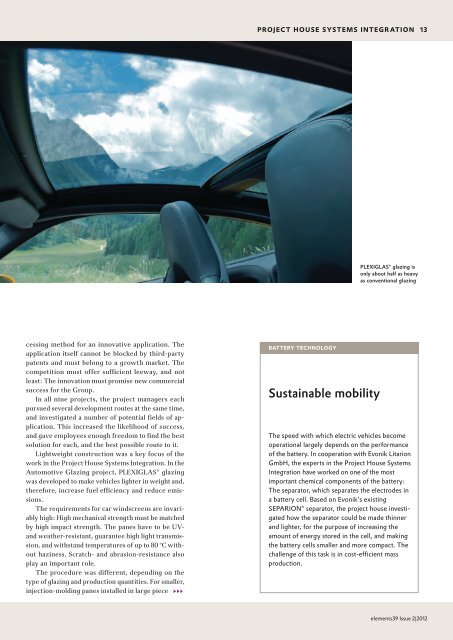Download - Evonik Industries
Download - Evonik Industries
Download - Evonik Industries
You also want an ePaper? Increase the reach of your titles
YUMPU automatically turns print PDFs into web optimized ePapers that Google loves.
cessing method for an innovative application. The<br />
application itself cannot be blocked by third-party<br />
patents and must belong to a growth market. The<br />
competition must offer sufficient leeway, and not<br />
least: The innovation must promise new commercial<br />
success for the Group.<br />
In all nine projects, the project managers each<br />
pursued several development routes at the same time,<br />
and investigated a number of potential fields of application.<br />
This increased the likelihood of success,<br />
and gave employees enough freedom to find the best<br />
solution for each, and the best possible route to it.<br />
Lightweight construction was a key focus of the<br />
work in the Project House Systems Integration. In the<br />
Automotive Glazing project, PLEXIGLAS® glazing<br />
was developed to make vehicles lighter in weight and,<br />
therefore, increase fuel efficiency and reduce emissions.<br />
The requirements for car windscreens are invariably<br />
high: High mechanical strength must be matched<br />
by high impact strength. The panes have to be UV-<br />
and weather-resistant, guarantee high light transmission,<br />
and withstand temperatures of up to 80 °C without<br />
haziness. Scratch- and abrasion-resistance also<br />
play an important role.<br />
The procedure was different, depending on the<br />
type of glazing and production quantities. For smaller,<br />
injection-molding panes installed in large piece 333<br />
PRoJeCt HoUse sYsteMs InteGRAtIon<br />
BAtteRY teCHnoLoGY<br />
Sustainable mobility<br />
PLeXIGLAS® glazing is<br />
only about half as heavy<br />
as conventional glazing<br />
The speed with which electric vehicles become<br />
operational largely depends on the performance<br />
of the battery. In cooperation with <strong>Evonik</strong> Lita rion<br />
GmbH, the experts in the Project House Systems<br />
Integration have worked on one of the most<br />
important chem ical components of the battery:<br />
The separator, which separates the electrodes in<br />
a battery cell. Based on <strong>Evonik</strong>’s existing<br />
SEPARION® separator, the project house investigated<br />
how the separator could be made thinner<br />
and lighter, for the purpose of increasing the<br />
amount of energy stored in the cell, and making<br />
the battery cells smaller and more compact. The<br />
challenge of this task is in cost-efficient mass<br />
production.<br />
13<br />
elements39 Issue 2|2012
















